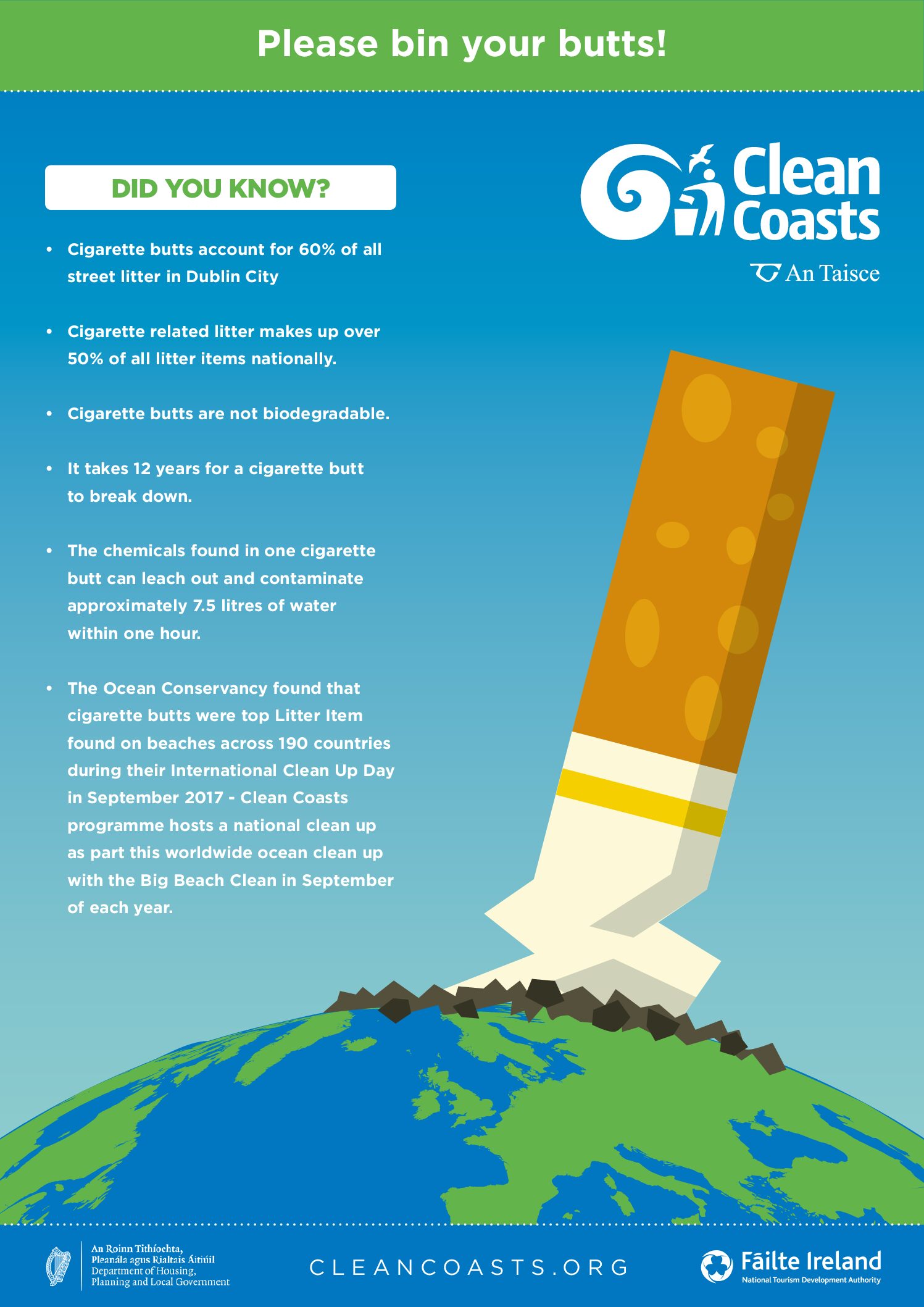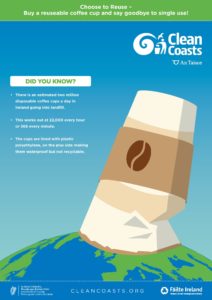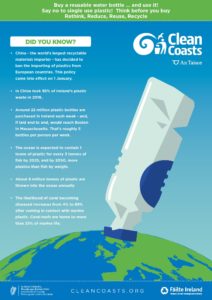Ocean Plastics
What’s the Problem
Approximately 10 million tonnes of litter end up in the world’s oceans and seas each year. The term “marine litter” or “marine debris” covers a range of materials which have been deliberately discarded, or accidentally lost on shore or at sea, and it includes materials that are carried out to sea from land, rivers, drainage and sewerage systems, or the wind (European Commission, 2013).
Plastics make up 85% of all marine litter from surface waters to deep-sea sediments (UNEP).
What we find on our beaches is not the full extent of the marine litter, including ocean plastics, load in the environment. It is estimated that 70% of marine litter is on the seabed, 15% is floating in the water column and 15% is what we find on our shores (OSPAR, 1995).
Sources of Ocean Plastics & Marine Litter
- Litter dropped in towns and cities
- Overflowing litter bins
- Litter dropped at the beach
- Poorly managed industrial waste discharges
- Lost shipping containers
- Lost/discharged fishing gear
- Recreational litter blown by the wind
- Poorly managed landfill sites
- Microbeads from personal care products
- Sewage related litter
Impacts of Ocean Plastics & Marine Litter
Marine litter kills, injures and causes pain and suffering and every year entails great economic costs and losses to people and communities around the world (United Nations Environment Programme, 2005).
Impacts to Marine Life:
- Entanglement of marine animals
- Ghost fishing: lost or abandoned fishing gear that continues to catch fish
- Ingestion by marine animals
- Spread of alien species by marine debris
Impacts to People and Economy:
- Ingestion of micropalstics
- Damage to fishing, fishing boats and gear
- Contamination of beaches
- Damage to the scenic quality of coastal areas
Facts and Figures
The oceans constitute 72% of the earth’s surface and are our primary oxygen suppliers. They are the primary source of food for more than half the world’s population.
Cigarettes

Did you know?
- Cigarette butts account for 60% of all street litter in Dublin City
- Cigarette related litter makes up over 50% of all litter items nationally.
- Cigarette butts are not biodegradable.
- It takes 12 years for a cigarette butt to break down.
- The chemicals found in one cigarette butt can leach out and contaminate approximately 7.5 litres of water within one hour.
Please bin your butts!
Coffee Cups
Did you know?
- There is an estimated two million disposable coffee cupsa day in Ireland going into landfill.
- This works out at 22,000 every hour or 366 every minute.
- The cups are lined with plastic polyethylene, on the plus side making them waterproof but not recyclable.
Choose to Reuse – Buy a reusable coffee cup and say goodbye to single use!
Plastic
Did you know?
- China – the world’s largest recyclable materials importer – has decided to ban the importing of plastics from European countries. This policy came into effect on 1 January.
- Around 22 million plastic bottles are purchased in Ireland each week – and, if laid end to end, would reach Boston in Massachusetts. That’s roughly 5 bottles per person per week.
Buy a reusable water bottle … and use it!
Say no to single use plastic?
Think before you buy
Rethink, Reduce, Reuse, Recycle
Climate Change In Our Oceans
Climate Change In Numbers
Climate Science
- The planet has not experienced such high levels of carbon dioxide (CO2) in the atmosphere for 4 million years
- The planet has not experienced such high levels of carbon dioxide (CO2) in the atmosphere for 4 million years
Effects
The extra heat (energy) in the atmosphere has multiple effects. The intensification of the water cycle means more water is evaporated from our oceans. Also, as the air gets warmer, it can hold more water vapour (which also has a greenhouse effect). Heavy downpours get heavier, causing more flooding.
- On a global basis 90% of the extra heat goes into the oceans. This is a factor in sea level rise, as the heated oceans expand.
- The extra carbon dioxide that is being absorbed by the oceans, has changed the acidity of the water by 25 – 30%, causing major problems for sea crustaceans i.e. crabs, oysters, to form their shells and is especially problematic for coral reefs. This change in acidity is causing ‘coral bleaching’, which kills the coral reefs
- Sea-level rise is also being caused by the melting of land based glaciers. The two main glacial ice-sheets are Greenland and Antarctica. The summer melt on Greenland’s ice sheet has increased by 30%
- Projections suggest an increase in global sea levels in the range of 0.26 to 0.55m for the low emissions scenario and 0.52-0.98m for the high emissions scenario. However, due to a limited understanding of some of the important effects that contribute to rates of increase, a best estimate for sea level rise cannot be provided with confidence, and estimates of up to 4-6 m have been projected by some models.
- Global sea level rose about 200mm (8 inches) in the last century. The rate in the last two decades, however, is nearly double that of the last century.
In The News
- Warmer oceans saw coral mortality of up to 50% in parts of Australia’s Great Barrier Reef and bleaching of 75% of Japan’s biggest reef. See here for more.
- Sea ice extent in Arctic and Antarctic reached record lows last November. The ‘almost unprecedented’ event attributed to warm temperatures and winds, with some areas more than 20C (36F) warmer than usual. See here for full story.
Climate Change in Ireland
Declining Arctic sea ice may increase the likelihood of cold continental air outbreaks over Ireland during winter.
Sea temperatures may rise by 2oC by the end of the century, causing intense, aggressive storms.
Levels of ocean acidity in sub-surface and deep offshore waters around Ireland have increased significantly over the period from 1991 to 2010. Increasing atmospheric CO2 is expected to result in increased oceanic acidity.
Changes would result in more drought, flooding, heavy rainfall and extreme temperatures that will, in turn, lead to changes in the range and prevalence of pests and diseases, and increased stress for animals.
The mean proportion of people living in coastal flood-prone areas is expected to increase, with one of the most notable increases happening in Ireland of 192%.
- Effects on fisheries sensitive to changes in temperature.
In Conclusion:
- Avoiding dangerous levels of climate change is still possible, but will require unprecedented effort and coordination from governments, businesses, citizens and scientists in the next three years, a group of prominent experts has warned.
- The world will look a very different place if it warms by 4oC by the end of the century. See link for a map of what the world will look like 4oC warmer.





